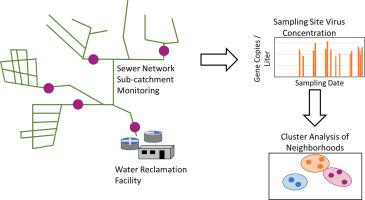Science of the Total Environment ( IF 8.2 ) Pub Date : 2021-09-17 , DOI: 10.1016/j.scitotenv.2021.150390 Laura Haak 1 , Blaga Delic 1 , Lin Li 1 , Tatiana Guarin 1 , Lauren Mazurowski 1 , Niloufar Gharoon Dastjerdi 1 , Aimee Dewan 1 , Krishna Pagilla 1

|
The response to disease outbreaks, such as SARS-CoV-2, can be constrained by a limited ability to measure disease prevalence early at a localized level. Wastewater based epidemiology is a powerful tool identifying disease spread from pooled community sewer networks or at influent to wastewater treatment plants. However, this approach is often not applied at a granular level that permits detection of local hot spots. This study examines the spatial patterns of SARS-CoV-2 in sewage through a spatial sampling strategy across neighborhood-scale sewershed catchments. Sampling was conducted across the Reno-Sparks metropolitan area from November to mid-December of 2020. This research utilized local spatial autocorrelation tests to identify the evolution of statistically significant neighborhood hot spots in sewershed sub-catchments that were identified to lead waves of infection, with adjacent neighborhoods observed to lag with increasing viral RNA concentrations over subsequent dates. The correlations between the sub-catchments over the sampling period were also characterized using principal component analysis. Results identified distinct time series patterns, with sewersheds in the urban center, outlying suburban areas, and outlying urbanized districts generally following unique trends over the sampling period. Several demographic parameters were identified as having important gradients across these areas, namely population density, poverty levels, household income, and age. These results provide a more strategic approach to identify disease outbreaks at the neighborhood level and characterized how sampling site selection could be designed based on the spatial and demographic characteristics of neighborhoods.
中文翻译:

下水道系统 SARS-CoV-2 废水监测的时空变异性和数据偏差
对 SARS-CoV-2 等疾病爆发的反应可能会受到在局部早期测量疾病流行率的能力有限的限制。基于废水的流行病学是一种强大的工具,可以识别从汇集的社区下水道网络或流入废水处理厂的疾病传播的疾病。然而,这种方法通常不应用于允许检测局部热点的粒度级别。本研究通过跨邻里规模下水道集水区的空间采样策略检查污水中 SARS-CoV-2 的空间格局。采样于 2020 年 11 月至 12 月中旬在 Reno-Sparks 大都市区进行。这项研究利用局部空间自相关检验来确定下水道流域中具有统计学意义的邻域热点的演变,这些热点被确定为导致感染浪潮,观察到相邻邻域在随后的日期随着病毒 RNA 浓度的增加而滞后。采样期间子流域之间的相关性也使用主成分分析来表征。结果确定了不同的时间序列模式,城市中心、偏远郊区和偏远城市化地区的下水道系统在采样期间通常遵循独特的趋势。几个人口参数被确定为在这些地区具有重要的梯度,即人口密度、贫困程度、家庭收入和年龄。









































 京公网安备 11010802027423号
京公网安备 11010802027423号